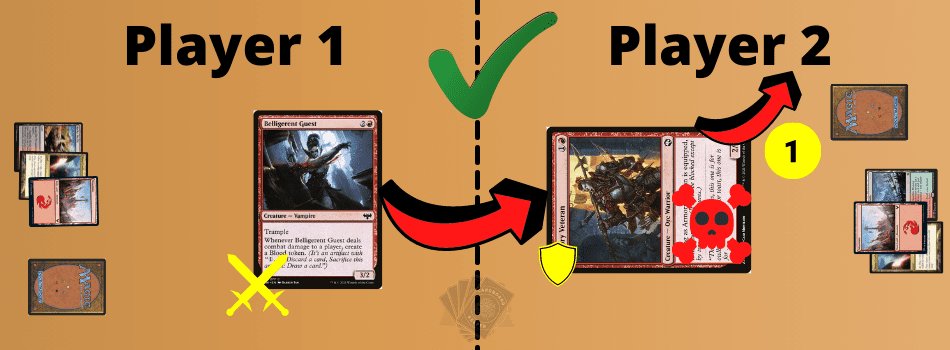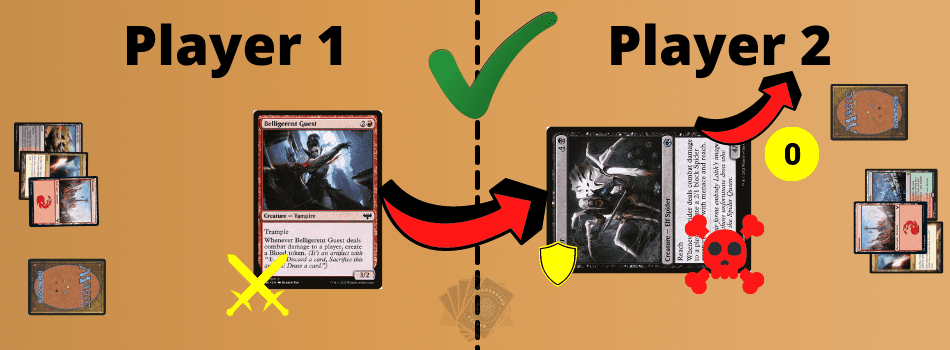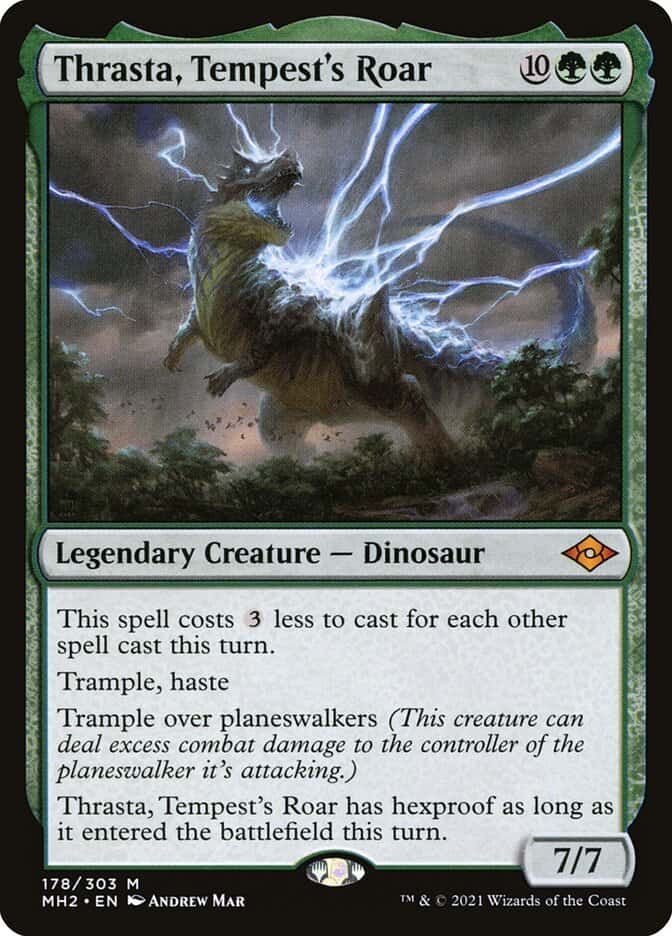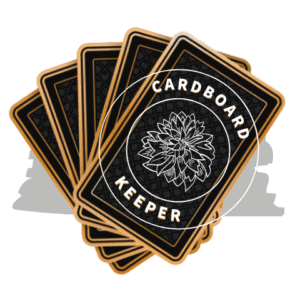MTG is a complicated game, and there’s little more complex than its keywords – like Trample. I’m sure we’ve all played a match where we’ve blocked an attacking creature only to take combat damage anyway. What’s up with that; how does Trample work in MTG?
If a creature with Trample has greater power than the toughness of the blocking creatures, it deals the excess damage to the defending player or planeswalker it attacked.
Now that we understand Trample basics, we can look at how this keyword mechanic functions in practice. This article will look at the most frequently asked questions about Trample in MTG and give examples to explain them.

How Do You Use Trample In Magic?
Suppose your opponent attacks you using Belligerent Guest, a 3/2 Vampire with Trample. I block using Armory Veteran, which is 2/2. In that case, I’d take one damage since their attacker has one more power than your Armory Veteran.
Now imagine that you block the 3/2 Belligerent Guest with your Drider instead. Because your creature is 3/3 instead, there’s no excess damage. The attacker’s power is equal to your blocker’s toughness. Even though it dies, Trample won’t apply.

From these examples, it becomes clear that we can use Trample in several ways.
First, Trample helps you use your creature to overcome a problematic board state. If your creature can consistently give combat damage despite blockers, they have a pseudo-evasion ability.
With Trample, you can advantage your creatures’ high power and end games where you might otherwise get overwhelmed with chump blockers.
So, Trample forces your opponent to make costlier blocks. Instead of blocking with a low-toughness creature, it causes your opponent to use a high-toughness creature so they don’t take damage – or kill your attacker.
Likewise, your opponent might block your Trample creature with multiple defenders to avoid taking damage. Given that many Trample creatures have powerful stats, this tactic is also an effective way to wipe out multiple creatures at once.
Similarly, the Trample keyword can make specific blocking strategies entirely unviable. Blocking with low toughness creatures will only destroy those creatures – it won’t protect your life total.
Furthermore, giving creatures the Trample ability is an efficient combat trick. That way, even though your opponent might defend, you can suddenly turn the tables and still damage them.
Trample creatures are also magnets for removal, but this isn’t always bad. Playing an intimidating card is an effective way to bait out your opponent’s removal spells, so your other threats can successfully reach the battlefield.
Last, remember that Trample is an evergreen keyword, so it appears in every set. It’s also one of the oldest keywords, seeing use since the Alpha edition. In this way, Trample is a staple of the game – and for a good reason.
What Is Trample Damage?
Trample damage is combat damage. Specifically, it is the damage that is left over after you’ve assigned lethal damage to each blocking creature.
Because of that, Trample damage can apply to several triggered abilities. You can activate a triggered ability that reads “whenever a creature deals combat damage to an opponent” with Trample damage.
Does Trample Work Defending?
Trample does not work when defending since the Trample keyword doesn’t give extra blocking rules.
It only assigns excess damage to the defending player. So, a blocking creature with a Trample ability won’t do anything different from another creature.
That means if I block an attacking creature with your Trample creature, I can’t deal any excess damage to that creature’s controller.
In this scenario, they’re the attacking player. They don’t take damage because they aren’t the defending player.
Does Trample Damage Go Through A Planeswalker?
Trample damage does not go through a planeswalker. The rules state that a creature with Trample deals excess damage exclusively to the player or planeswalker it was attacking. Because you can only choose to attack one player or planeswalker with each creature, you cannot direct the excess damage to another.

Thrasta, Tempest’s Roar is a unique case.
This card has two Trample abilities – the regular Trample keyword and then Trample over planeswalkers, too. So, it can deal excess damage to the planeswalker’s controller it attacks. However, normal Trample creatures cannot.
How Does Deathtouch Work With Trample?
Deathtouch has a potent synergy with Trample.
Because a creature with Trample needs to assign lethal damage to each of its blockers before dealing excess damage to a player, Deathtouch becomes beneficial.
A creature with Deathtouch only needs to assign one damage to each creature blocking it. That’s because any amount of damage a Deathtouch creature deals should be lethal.
So, by combining these abilities, your attacking creatures can deal significantly more damage to your opponents.
However, creatures with Trample aren’t immune to Deathtouch. So, beware of attacking with your Trample creature into Deathtouch blockers. Even though your creatures might still kill these defenders and deal heavy damage to your opponent, it will be a suicide mission.
Does First Strike Stop Trample?
The first strike keyword can stop Trample. If the blocking creature has high enough power to kill the attacking creature with Trample, then damage won’t apply. The attacking creature will be dead before it has a chance to deal any damage.
On the other hand, the first strike ability has a powerful combo with Trample.
A creature with Trample and first strike is deadly in combat since it can kill its blockers without damage. Then it can safely deal the extra damage to the defending player. And it can safely do this trick multiple times.
Does Indestructible Prevent Trample?
Indestructible does not prevent Trample. That is because a creature with a Trample keyword only needs to assign lethal damage to the blocking creature before assigning the rest to the defending player.
So, even if a creature is indestructible, it is not immune to Trample.
While this lethal damage might not destroy the creature, I still receive the excess damage. That’s because the creature would’ve died if it didn’t have Trample.
MTG Trample Rules
702.19a Trample is a static ability that modifies the rules for assigning an attacking creature’s combat damage. The ability has no effect when a creature with trample is blocking or is dealing noncombat damage. (See rule 510, “Combat Damage Step.”) (Source)
702.19b The controller of an attacking creature with trample first assigns damage to the creature(s) blocking it. Once all those blocking creatures are assigned lethal damage, any excess damage is assigned as its controller chooses among those blocking creatures and the player or planeswalker the creature is attacking. When checking for assigned lethal damage, take into account damage already marked on the creature and damage from other creatures that’s being assigned during the same combat damage step, but not any abilities or effects that might change the amount of damage that’s actually dealt. The attacking creature’s controller need not assign lethal damage to all those blocking creatures but in that case can’t assign any damage to the player or planeswalker it’s attacking.
Example: A 2/2 creature that can block an additional creature blocks two attackers: a 1/1 with no abilities and a 3/3 with trample. The active player could assign 1 damage from the first attacker and 1 damage from the second to the blocking creature, and 2 damage to the defending player from the creature with trample.Example: A 6/6 green creature with trample is blocked by a 2/2 creature with protection from green. The attacking creature’s controller must assign at least 2 damage to the blocker, even though that damage will be prevented by the blocker’s protection ability. The attacking creature’s controller can divide the rest of the damage as they choose between the blocking creature and the defending player.
702.19c If an attacking creature with trample is blocked, but there are no creatures blocking it when damage is assigned, all its damage is assigned to the player or planeswalker it’s attacking. (Source)
702.19d If a creature with trample is attacking a planeswalker, none of its combat damage can be assigned to the defending player, even if that planeswalker has been removed from combat or the damage the attacking creature could assign is greater than the planeswalker’s loyalty.
702.19e Multiple instances of trample on the same creature are redundant.
Final Thoughts
In conclusion, Trample is a keyword ability that allows your attacking creatures to deal excess damage to your opponent. It’s a powerful ability that lets you get the most value out of your creatures and forces your opponent to block differently.
